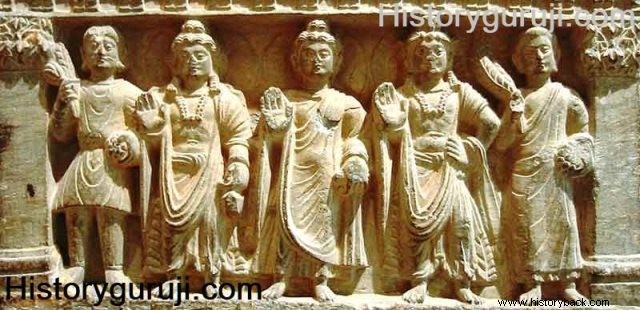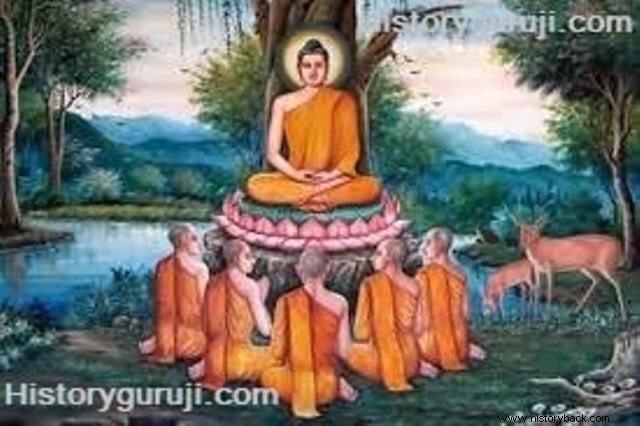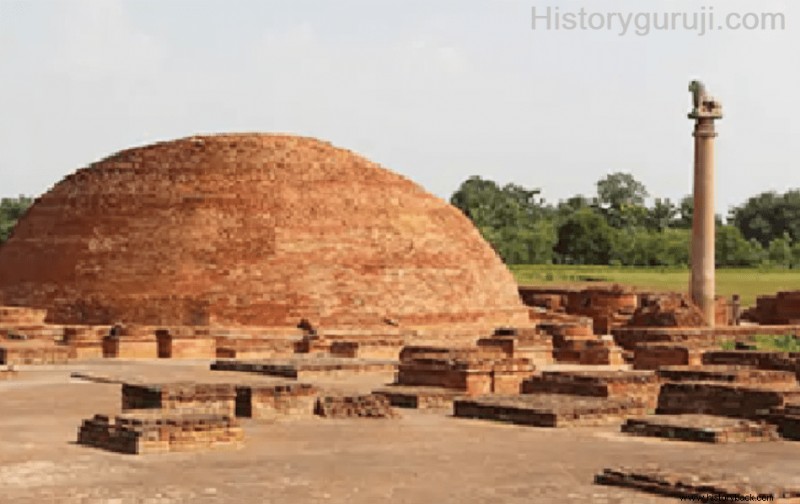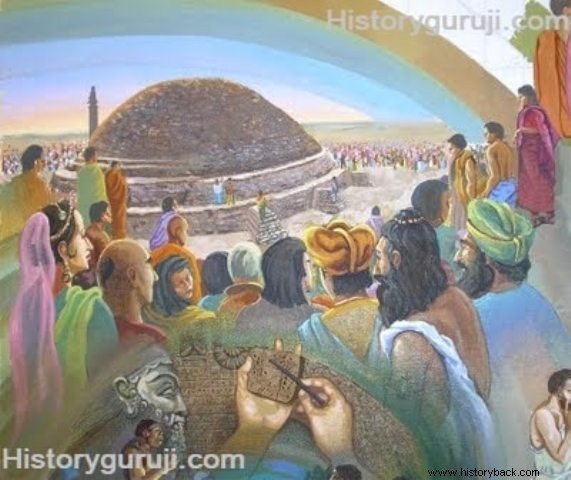Initially the British historians believed that India has always been ruled by autocratic kings, Indians have been used to autocracy since ancient times. But in 1903 AD Reese Davids It became clear from the discoveries of ancient India that republics existed along with monarchies in ancient India. Kashiprasad Jaiswal The first is the Indian historian who told that in ancient times there were two types of states in India - one Rajadhin (Monarchy) and the other Ganadhi (Republic). The monarchy was also called monolithic. Where Gana or many persons were ruled, they were called Ganadhan States.
Buddhist texts of the second century AD It shows that when some merchants of Madhyadesh went to South India and the people there asked about their state system, they told that some countries are under the Ganas and some of the kings. Jain text Acharangasutra The monks are warned to avoid visiting places where the republic is ruled. Panini has also described Sangh as different from monarchy and called Gana as synonymous with Sangh. In Kautilya's Arthashastra There is also mention of two types of union states- one 'negotiator' That is, dependent on trade, agriculture, animal husbandry and war and others 'Rajshabdopjeevi' That is, from a state that used to hold the title of king. In the first class the relation of Kshatriyas with Kamboja and Surashtra has been told and in the second class the Lichchhavis, Vrajjis, Mallas, Madras, Kukurs, Panchalas etc. have been enumerated. In fact both 'Sangha' and 'Gana' are synonymous and were political organizations prevalent in many parts of the country.

Greo-Roman writers also wrote republics in ancient India According to which at the time of Alexander's invasion there were many republics in Punjab and Indus which were different from monarchies. Returning to Sikandar, Malavas, Ambashtha and Kshudraka had got democratic states. The currency evidence also sheds light on the republics. On the coins received from the republics like Malava, Arjunayan, Yaudheya, there is no mention of the king but the mention of the gana. Megasthenes has written that republican rule was prevalent in many Indian cities during his time. It is thus clear that republics existed in ancient India and they differed from monarchies in the sense that their rule was not governed by a hereditary king but by a gana or a sangha. But the republics of ancient India were different from the republics of the modern period in the sense that the governance in them was not conducted by the entire subjects but by the prominent persons of a particular clan.
Condition of India in the 6th century BC:Sixteen Mahajanapadas (The States of India in the Sixth century BC:Sixteen Mahajanapadas)
Buddhist Republic

It is known from ancient texts that Lord Mahavira and Many republics also existed in North-East India during the time of Buddha. At present 10 republics like Lichchavi, Videha, Shakya, Malla, Koliya, Moriya, Buli and Bhagga They were spread from Tirhut to Kapilvastu. Among the major republics of Buddha were the Sakyas of Kapilavastu and the Lichchhavis of Vaishali, the Bhagas of Sumsumara Parvat, the Kalams of Kesaputra, the Koliyas of Ramgram, the Mallas of Kushinara, the Mallas of Pava, the Moriyas of Pippalivan and the Buli of Alkalpa Important were-
Kapilvastu Ke Sakya
Talai of Nepal In the north of the Shakya republic, the mountain Himalayas flowed, in the east the Rohini river and in the south and west the Rapti river flowed. Its capital was Kapilvastu, which is identified with modern Tilaurakot in Nepal. Some historians identify it as Piprahwa of Siddharthnagar district Also from a place called, from where the remains of the Buddhist stupa and the metal-manjusha have been found. According to Pali texts Shakya eKshwakuvanshiya Kshatriya Were. Some historians estimate that due to his proximity to Shakavan, he was called Shakya Got the name Due to its proximity to Kapil Ashram, this city became famous as Kapilvastu.
According to Buddhist texts there are about Eighty thousand families in the Shakya Republic Were. Gautam Buddha was born in this republic, so the importance of this republic had increased. The other cities of this republic were Chatuma, Samgam, Khomdus, Silawati, Nagarak, Devdah, Shakkar etc. The daughter of Buddha's mother Devdahnagar She was The Shakya republic was never very important as a political power and it accepted the suzerainty of the Kosala kingdom. The Shakyas were extremely proud of the purity of their blood. This is the reason that when the Kosala king Prasenjit sent a proposal to marry the Shakya princess, the Shakyas accepted that proposal out of fear, but sent Vasbhakhatiya, the daughter of a maidservant, to Prasenjit's service. It is said that the destruction of this republic Vidudabh, son of Vasbhakhtiya Happened at the hands of.
Vaishali's Lichchavi

In Buddha's time biggest and Vaishali located in the mighty republic of Bihar belonged to the Lichchhavis. Vaishali was the capital of the Licchavi republic. Vaishali's equation from Basadh which is in modern Muzaffarpur. This kingdom was founded by Vishal, the son of Suryavanshi king Ikshvaku. In Buddhist, Jain and Brahmin literature, Lichchhavis are Kshatriyas of the elite clan It has been told. Mahaparinibbanasutta According to it, the Lichchhavis had demanded the relics of Buddha only on the basis of being Kshatriya. In Sigal Jataka, a Lichchavi girl is called a 'Kshatriya daughter' Having said. In Jain literature also Lichchhavis have been described as Kshatriyas. Lord mother of Mahavira, the Lichchavi princess She was also called Kshatrani. The Brahmin texts also refer to the Lichchhavis as Kshatriyas. The Chinese traveler Hiuen Tsang has also accepted the Lichchhavis as Kshatriyas. BC The Lichchavi kingdom of Vaishali changed from a monarchy to a republic in the seventh century. Licchhavis had built the famous Kutagarshala in Mahavan for the abode of Mahatma Buddha , Chelna, the daughter of the Lichchavi ruler Chetak, was married to the Magadha king Bimbisara. The Lichchhavis were a hindrance to the rising kingdom of Magadha with their power and prestige, but they did not lag behind in their defense and they formed a union with the Mallas and sometimes with other nearby ganas, which became famous as Vajjisangh.>
BC Intellectual Movement in the Sixth Century BC
Mithila Ke Videha
Situated in the areas of Bhagalpur and Darbhanga districts of Bihar, this state was earlier a monarchical system. During the Buddha period, it was converted into a union state. Members of Videha Log Vajji Sangh Were. Its capital was Mithila whose equation is present Janakpur is done from. In Mahajanak Jataka, Mithila is described as rich, vast, illuminated from all sides and with pylons. According to this person, foundation of Mithila Videha had done. The Videha was politically sound and had matrimonial ties with contemporary dynasties. Bimbisara had a queen Vaidehi. According to Bhasa's swapnavasavadatta, Udayana Vaidehiputra himself Were. Mahavir's mother Trishala is also Videha princess She was Mithila was a famous trading center during the time of Buddha.
Parts of Mount Sussumar
Sussumar mountain is equated with Chunar in Mirzapur district. The region between the Yamuna and Son rivers of the Vindhya region was located under the jurisdiction of the Republic of God. Possibly related to the Bhaga clan mentioned in Bhaga Aitareya Brahmana Were. The Bhaga people accepted the suzerainty of Vatsa because Bodhikumar, son of Vatsaraj Udayana, resided in a building named Koknad built at Sussumaragiri used to.
Alkalp Ke Bullies
The ancient republic of bullies of Bihar Shahabad, Arrah and Muzaffarpur was located between the districts. The Buli had a close association with Baithdweep and this was the capital of the Buli. Some scholars Equation of Vethdweep from Kasia even do. The Mahaparinibbanasutta tells us that after the death of the Buddha, the bullies had built a stupa on it at Alakappa after receiving his ashes. This suggests that the Bulli were related to the Shakyas.
Kesputta's Kalam
Presumably this republic extended from Kundwar in Sultanpur district to a place called Palia in the west of Koshal. It is known from Vedic literature that Kalams are related to the Keshis of Panchal district was. Alar Kalam's Acharya of this republic The first sermon was received by Gautama Buddha, who lived near Uruvela. Kapilvastu, the ashram of a another Acharya Bharandu of this republic was in Kesputtiyasutta suggests that the Kalamas accepted the suzerainty of Kosala.
Ramgam Ke Koliy
East of the Shakya Republic was the republic of the Kolis of Ramgam. Ramgam, the capital of the Kolis, is identified with the modern Devkali village or the present day Rampur Karkhana (Deoria). But it is equated with the present Ramgarh Tal of Gorakhpur should be done. According to the Pali tradition, the Kolis were also Ikshvakuvanshi Kshatriyas like the Shakyas and were related to each other. The Rohini river flowed between the Shakya and the Koli republic and the people of both the states used the water of the Rohini river for drinking and irrigation, so there were frequent conflicts between the Shakyas and the Kolis over the sharing of the waters of the Rohini river. Rukhdhamma and Phandan Jataka reveal that at the time when Shasta Jetavan had Rs. At the same time, a situation of fierce struggle for water had arisen between the Sakyas and the Kolis, but the Buddha intervened and pacified this conflict.
Kushinara's Mall
Kushinara is identified around 34 km from Deoria. The answer is done from the mound of Anurudhwa village situated near the present Kasaya. A copper plate has also been found from here on which the article 'Parinirvana Chaitya Tamrapatta Iti' is engraved. The article 'Shri Mahaparinirvana Vihara Bhikshusanghasya' is also found on some of the mudras obtained from here. In Valmiki Ramayana, the Mallas are the son of Lakshmana the descendant of Chandraketu Malla has been mentioned.
Pava Ke Mall
Pava of modern Deoria district Padrauna Although some historians are in favor of identifying it with Fazil Nagar. It is known from Jain literature that due to the fear of Magadha king Ajatashatru, the Mallas formed a union with the Lichchhavis. But Ajatushatru defeated the Lichchhavis after defeating the Mallas as well.
Pipplivan's More
The people of the Republic of Moriah were a branch of the Sakyas. Mahavanshtika It is revealed that the people of the Sakya dynasty, who fled to the Himalayan region to escape the atrocities of the Kosala king Vidudabha, built a town called Pippalivan in a place resonant with peacocks. settled. Because of being a resident of the land of peacocks, he was called Moriyya. According to Mahaparinibbanasutta, Moriya was one of the claimants for the ashes of Lord Buddha who could not get the relics due to his late arrival. Mauryan emperor Chandragupta was born in this Maurya Republic. Although Pipplivan is equated with Rajdhani village located near Kusumhi in Gorakhpur district But it is more appropriate to equate it with Piprahwa of Siddharthnagar.
Government of the Republic

The welfare of subjects in a republican government far and wide is pervasive. The President of the Gana's Executive is an elected office bearer who was called the chief hero or king of the republic. Along with looking after the general administration, it was his duty to maintain internal peace and harmony in the republic. Its work was to collect taxes and build roads etc. for the public. Other office-bearers Uparaja, Senapati, Bhandagarik etc. were prominent.
Rise of Magadha:Contribution of Haryanka, Shishunag and Nanda Dynasty
Supreme Sabha (Gana Sabha) or Sansthagar
The real power of a republic is a Supreme Sabha (Gana Sabha) or Sansthagar was vested in it, which was like a parliament. The number of members of this assembly was fixed by tradition. In fact, the unit of formation of the gana was the total. One person from each clan was a member of the Gana Sabha. Each patriarch or member of the Gana Sabha has the federal title 'Raja' There was According to Ekpanna Jataka, there are 7,707 kings in the Central Committee of the Republic of Lichchivi And so were the number of vice-rajas and generals and treasurers. The number of members of the Sansthangar (Ganasabha) of the Shakyas at one place is stated to be 500. ये संभवतः राज्य के कुलीन परिवारों के सदस्य थे जो ‘राजा’ की उपाधि धारण करते थे। प्रत्येक राजा के अधीन उपराजा, सेनापति, भांडागारिक आदि पदाधिकारी होते थे। लगता है कि लिच्छवि राज्य अनेक छोटी-छोटी प्रशासनिक इकाइयों में विभक्त था और प्रत्येक इकाई का अध्यक्ष एक राजा होता था जो अपने अधीन पदाधिकारियों की सहायता से उस इकाई का शासन संचालित करता था।
संस्थागार की कार्यवाही
गणसभा में गण के समस्त प्रतिनिधियों को सम्मिलित होने का अधिकार था, किंतु सदस्यों की संख्या कई सहस्र तक होती थी, इसलिए विशेष अवसरों को छोड़कर उपस्थिति प्रायः सीमित ही रहती थी। शासन के लिए अंतरंग अधिकारी नियुक्त किये जाते थे। किंतु नियम-निर्माण का पूरा दायित्व गणसभा पर ही था। इस सभा में राजनीतिक प्रश्नों के अतिरिक्त और भी अनेक प्रकार के सामाजिक, व्यावहारिक और धार्मिक प्रश्न भी विचारार्थ आते रहते थे। गणराज्यों से संबंधित सभी महत्त्वपूर्ण विषयों, जैसे- संधि-विग्रह, कूटनीतिक संबंध, राजस्व-संग्रह आदि के ऊपर गणसभा के सदस्य संस्थागार में उपस्थित होकर पर्याप्त वाद-विवाद के पश्चात् बहुमत से निर्णय करते थे। रोहिणी जल-विवाद और विडूडभ के आक्रमण के समय शाक्यों ने अपनी राजधानी के केंद्रीय संस्थागार में उपस्थित होकर पर्याप्त वाद-विवाद के बाद ही निर्णय किया था। लिच्छवि गणराज्य में भी सेनापति खंड की मृत्यु के बाद सेनापति सिंह की नियुक्ति संस्थागार के सदस्यों द्वारा निर्वाचन के आधार पर की गई थी। कुशीनारा के मल्लों ने बुद्ध के अंतयेष्ठि और उनकी धातुओं के संबंध में अपने संस्थागार में विचार-विमर्श किया था , इस प्रकार स्पष्ट है कि गणराज्यों का शासन प्रजातांत्रिक ढ़ंग से संचालित किया जाता था। इस प्रकार संस्थागार की कार्यवाही आधुनिक प्रजातंत्रात्मक संसद के समान थी।
इन गणों के विधान का विवरण जैनसूत्रों व महाभारत में मिलता है। संस्थागार की कार्यवाही के संबंध में पता चलता है कि प्रत्येक सदस्य के बैठने की अलग व्यवस्था थी। इस कार्य के लिए ‘आसनपन्नापक ’ नामक पदाधिकारी होता था। कोरम की पूर्ति, प्रस्ताव रखने, मतगणना आदि के लिए सुस्पष्ट और निश्चित नियम थे। गणसभा में नियमानुसार प्रस्ताव रखा जाता था। उसकी तीन वाचना होती थी और विरोध होने पर शलाकाओं द्वारा गुप्त मतदान प्रणाली से मतदान करके निर्णय लिया जाता था। मतदान-अधिकारी को ‘शलाका-ग्राहक’ कहा जाता था। प्रत्येक सदस्य को अनेक रंगों की शलाकाएँ दी जाती थीं। विशेष प्रकार के मतदान के लिए विशेष प्रकार की शलाकाएँ होती थीं। मत के लिए ‘छंद’ शब्द का प्रयोग किया जाता था। अनुपस्थित सदस्य के भी मत लेने के नियम थे। गणसभा के कार्यों को सकुशल संपन्न कराने के लिए अनेक पदाधिकारी होते थे। गणपूरक नामक पदाधिकारी गणसभा का सचेतक था, वह गण की बैठकों में कोरम पूर्ण करवाता था और अन्य कार्यवाही संपन्न करवाता था। गणों की कार्यपालिका का अध्यक्ष ही संभवतः संस्थागार का भी प्रधान होता था।
मौर्य सम्राट चंद्रगुप्त मौर्य (Maurya Emperor Chandragupta Maurya)
मंत्रिपरिषद्
सामान्यतया गणराज्यों की गतिविधियों पर गणसभा का पूर्ण नियंत्रण होता था। संभवतः गणराज्यों में एक मंत्रिपरिषद् भी होती थी जिसमें चार से लेकर बीस सदस्य होते थे। गणाध्यक्ष ही मंत्रिपरिषद् का प्रधान होता था , राज्य के उच्च पदाधिकारियों, मंत्रियों तथा प्रादेशिक शासकों की नियुक्ति प्रायः गणसभा द्वारा की ही जाती थी। यही केंद्रीय समिति (गणसभा) राष्ट्रीय न्यायाधिकरण (सर्वोच्च न्यायालय) के रूप में भी कार्य करती थी।
न्याय-व्यवस्था
बुद्धघोष की टीका सुमंगलविलासिनी से वज्जिसंघ की न्याय-व्यवस्था के संबंध में पता चलता है कि इस संघ में आठ न्यायालय थे और किसी को तभी दंडित किया जा सकता था जब उसे एक-एक करके आठों न्यायालय दोषी सिद्ध कर दें। राजा का न्यायालय अंतिम होता था। प्रत्येक न्यायालय अपराधी को निर्दोष होने पर मुक्त तो कर सकता था, किंतु अपराध सिद्ध होने पर दंडित नहीं कर सकता था। वह उसे उच्चतर न्यायालय में भेज देता था। दंड देने का अधिकार केवल राजा को था। राजा दंड देते समय पूर्व-दृष्टांतों ‘पवेनिपोट्ठक ’ का अनुसरण करता था। इन न्यायालयों के प्रधान अधिकारी विनिच्चय महामात्त, वोहारिक, सूत्ताधार, अट्ठकुलक, भांडागारिक, सेनापति, उपराजा और राजा Were. वज्जि गणराज्य में बहुत बड़े अपराध पर ही प्राणदंड की सजा दी जाती थी।
गणराज्यों के विवरणों से लगता है कि गणराज्य पर्याप्त समृद्ध और संपन्न थे। गणराज्यों में ग्राम पंचायतें भी होती थीं जो राजतंत्रात्मक राज्यों की ग्राम पंचायतों की भाँति कार्य करती थीं। ये ग्राम पंचायतें कृषि, उद्योग, व्यापार आदि के विकास का ध्यान रखती थीं। अधिकतर गणराज्य या गणसंघ बौद्ध धर्मानुयायी Were. महापरिनिर्वाणसूत्र से ज्ञात होता है कि बुद्ध ने वज्जिसंघ की कार्यप्रणाली की बड़ी प्रशंसा की थी , उन्होंने बौद्ध भिक्षुओं के संप्रदाय को भिक्खु संघ की संज्ञा दी। युद्ध से गण की स्थिति सकुशल नहीं रहती, इसलिए गणों ने प्रायः शम या शांति की नीति अपनाई। इन गणराज्यों के पास अपनी कोई सेना नहीं होती थी, गणराज्य का प्रत्येक नागरिक अस्त्र-शस्त्र की विद्या में निपुण होता था और आवश्यकता पड़ने पर सैनिक का कार्य करता था। गणराज्य जब तक संघ-जीवन के नियमों का पालन करते थे, अपराजेय थे।
बुद्धकालीन सोलह महाजनपदों एवं गणतंत्रात्मक राज्यों की पारस्परिक शत्रुता और संघर्ष के परिणामस्वरूप ई.पू. छठी सदी के उत्तरार्द्ध तक कई छोटे महाजनपद और गणतंत्र शक्तिशाली महाजनपदों की विस्तारवादी नीति का शिकार होकर या तो उन्हीं में विलीन हो गये या फिर महत्त्वहीन हो गये। कोशल ने काशी का गौरव धूल में मिला दिया, तो मगध ने अंग के ऐश्वर्य की इतिश्री कर दी। अवंति भी चेदि के कुछ भाग पर अपना प्रभुत्व स्थापित कर वत्स की सीमा स्पर्श करने लगा। बुद्धकाल तक आते-आते समस्त उत्तर भारत की राजनीति में केवल चार महत्त्वपूर्ण शक्तिशाली राजतंत्रों- कोशल, वत्स, अवंति और मगध ने प्रसिद्धि प्राप्त की और इन्हीं चारों की तूती बोल रही थी। कोशल में स्वनामधन्य प्रसेनजित, वत्स में भास के स्वप्नवासवदत्ता के धीरोदात्त नायक उदयन, अवंति में सैनिक शक्ति के पुंज महासेन चंडप्रद्योत तथा मगध में हर्यंक कुल के नायक बिंबिसार अपनी साम्राज्यवादी नीति से पड़ोसियों पर अपना प्रभुत्व स्थापित करने का प्रयास करने लगे।
गणराज्यों का पतन
भारतवर्ष में लगभग एक सहस्र वर्षों छठी शताब्दी ई. पू. से चौथी सदी ई. तक गणराज्यों के उत्थान-पतन का इतिहास मिलता है। नवीन पुरातात्त्विक उत्खननों में गणराज्यों के कुछ लेख, सिक्के और मिट्टी की मुहरें प्राप्त हुई हैं, विशेषकर यौधेय गणराज्य के संबंध में कुछ प्रमाणिक सामग्री प्राप्त हुई है। गणराज्यों की झलक गुप्त साम्राज्य के उदयकाल तक दिखाई पड़ती है। धरणिबंध के आदर्श से प्रेरित समुद्रगुप्त के सैनिक अभियानों के कारण अधिकांश गणराज्य गुप्त साम्राज्य में विलीन हो गये।
भारतीय इतिहास के वैदिक युग में जनों अथवा गणों की प्रतिनिधि संस्थाएं विदथ, सभा और समिति थीं। कालांतर में उन्हीं का स्वरूप वर्ग, श्रेणी, पूग और जानपद आदि में रूपांतरण हो गया। राजतंत्रात्मक और गणतंत्रात्मक परंपराओं का संघर्ष चलता रहा। गणराज्य राजतंत्र में और राजतंत्र गणराज्य में बदलते रहे।
गणराज्यों की अकेलेपन की नीति और मतैक्य का अभाव, उनके विनाश के कारण बने। मगध के महत्त्वाकांक्षी शासक वैदेहीपुत्र अजातशत्रु ने भी गणराज्यों की स्वतंत्रता पर प्रहार किया, जिससे छोटे और कमजोर गणराज्य साम्राज्यवाद की धारा में समाहित हो गये। अजातशत्रु और वर्षकार की नीति चंद्रगुप्त और चाणक्य का आदर्श थी। अब साम्राज्यवादी शक्तियों का सर्वात्मसाती स्वरूप सामने आया और अधिकांश गणतंत्र मौर्यों के विशाल एकात्मक शासन में विलीन हो गये।
परंतु गणराज्यों की आत्मा नहीं दबी। सिकंदर की तलवार, अजातशत्रु का प्रहार, मौर्यों की मार अथवा हिंद-यवनों और शक-कुषाणों की आक्रमणकारी बाढ़, उनमें से मात्र कुछ निर्बलों को ही बहा सकी। अपनी स्वतंत्रता का हर मूल्य चुकाने को तैयार मल्लोई (मालव), यौधेय, मद्र और शिवि पंजाब से नीचे उतरकर राजपूताना में प्रवेश कर गये और शताब्दियों तक उनके गणराज्य बने रहे। उन्होंने शाकल आदि अपने प्राचीन नगरों का मोह छोड़कर माध्यमिका तथा उज्जयिनी जैसे नये नगर बसाये, अपने सिक्के चलाये और अपने गणों की विजयकामना की। मालव गणतंत्र ने शकों को पराजित कर अपने गण की पुनर्स्थापना की और इस विजय की स्मृति में ई.पू. 57-56 में एक नया संवत् चलाया, जो विक्रम संवत् के नाम से प्रसिद्ध है और जो आज भी भारतीय गणना-पद्धति का प्रमुख आधार है।
प्रतिभाशाली गुप्त सम्राटों की साम्राज्यवादी नीति ने गणतांत्रिक स्वतंत्रता की भावना की अंतिम लौ को बुझा दिया। भारतीय गणों में प्रमुख लिच्छवियों के ही दौहित्र समुद्रगुप्त ने उनकी स्वतंत्रता का हरण कर लिया। उसने मालव, आर्जुनायन, यौधेय, काक, खरपरिक, आभीर, प्रार्जुन एवं सनकानीक आदि को प्रणाम, आगमन और आज्ञाकरण के लिए बाध्य कर धरणि-बंध के आदर्श को पूर्ण did. यह भारतीय गणराज्यों के भाग्य-चक्र की विडम्बना ही थी कि उन्हीं के सगे-संबंधियों ने उन पर प्रहार किया, जैसे- वैदेहीपुत्र अजातशत्रु, मोरियगण के राजकुमार चंद्रगुप्त मौर्य, लिच्छवि-दौहित्र समुद्रगुप्त, किंतु गणतंत्रीय भावनाओं को मिटा पाना सरल नहीं रहा और अहीर तथा गूजर जैसी अनेक जातियों के रूप में यह भावना कई शताब्दियों तक पनपती-पलती रही।
आज साम्राज्यों और सम्राटों के नामोनिशान मिट चुके हैं तथा निरकुंश और असीमित राज्य-व्यवस्थाएं समाप्त हो चुकी हैं, किंतु स्वतंत्रता की वह मूलभावना मानव-हृदय से नहीं दूर की जा सकती जो गणराज्य परंपरा की कुंजी है। विश्व इतिहास के प्राचीन युग के गणों की तरह आज के गणराज्य अब न तो क्षेत्र में अत्यंत छोटे हैं और न आपस में फूट और द्वेषभावना से ग्रस्त। उनमें न तो प्राचीन ग्रीक का दासवाद है और न प्राचीन और मध्यकालीन भारत और यूरोप के गणराज्यों का सीमित मतदान। उनमें अब समस्त जनता का प्राधान्य हो गया है और उसके भाग्य की वही विधायिका है। अब तो सैनिक अधिनायकवादी भी जनवाद का दम भरते हैं और कभी-कभी उसके लिए कार्य भी करते हैं। गणराज्य की भावना अमर है और उसका जनवाद भी सदैव अमर रहेगा।
छठी शताब्दी ईसापूर्व में भारत की दशा :सोलह महाजनपद (The States of India in the Sixth century BC:Sixteen Mahajanapadas)
ई.पू. छठी शताब्दी में बौद्धिक आंदोलन (Intellectual Movement in the Sixth Century BC)
